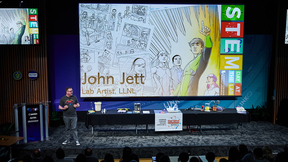S&TR Magazine Highlights the Inertial Confinement Fusion (ICF) Program
The last U.S. underground nuclear explosive tests, which were key to assessing the design and viability of the country’s nuclear weapons, occurred over 27 years ago. However, the need for deeper understanding of the complex physical processes that drive nuclear weapon performance and for putting stockpile design and assessment on a solid science-based foundation continue to be of utmost importance to the nation.
A core mission of the Department of Energy’s (DOE’s) National Nuclear Security Administration (NNSA) is to ensure this stockpile remains safe, secure, and reliable, without further underground testing. Lawrence Livermore’s Inertial Confinement Fusion (ICF) program supports the Stockpile Stewardship Program (SSP) mission by seeking to recreate and examine the processes that occur in the heart of burning stars and nuclear weapons, through heating a tiny amount of encapsulated fusion fuel and compressing it to the point that nuclear fusion reactions occur. The data from experiments at ICF facilities help to refine computer models used to better understand and assess the performance of the stockpile’s aging nuclear weapons. These experiments also provide an opportunity for weapon designers, experimentalists, engineers, and staff to tackle challenging design problems in the absence of underground nuclear explosive testing, thereby developing and refining the skills needed to support the SSP. This dedicated workforce turns to platforms of immense energy and engineering prowess, such as the world’s largest and most energetic laser—the NNSA’s 192-beam National Ignition Facility (NIF), located at Livermore—to meet the SSP mission, now and in the future.
Read the full S&TR article, Fusion Supports the Stockpile.
Contact
Ann ParkerTags
Lasers and Optical S&TLasers
National Ignition Facility and Photon Science
Science
Strategic Deterrence
Featured Articles








